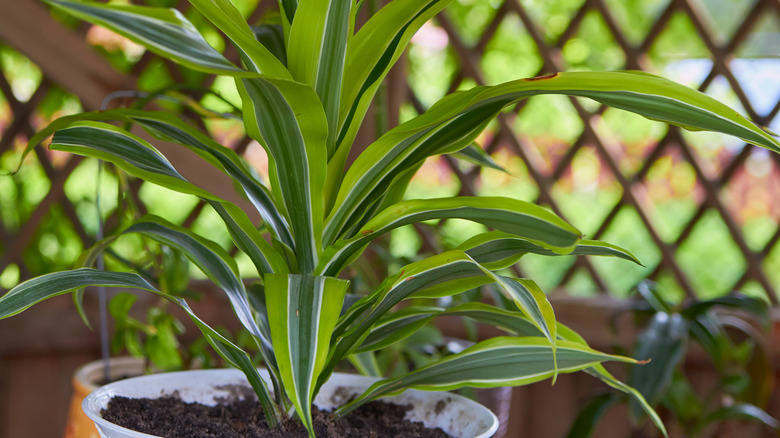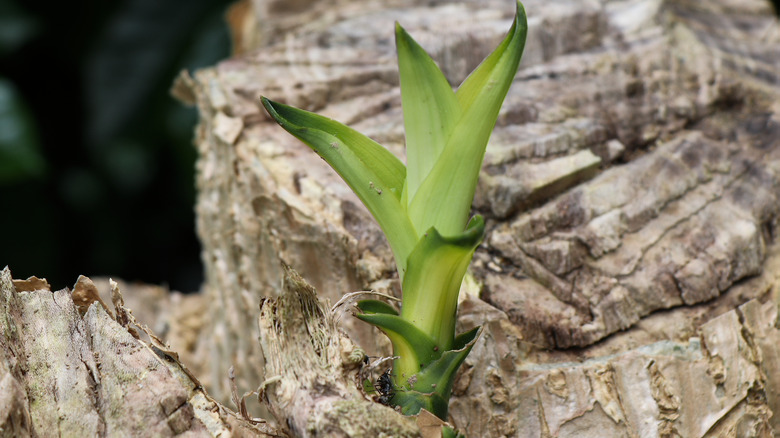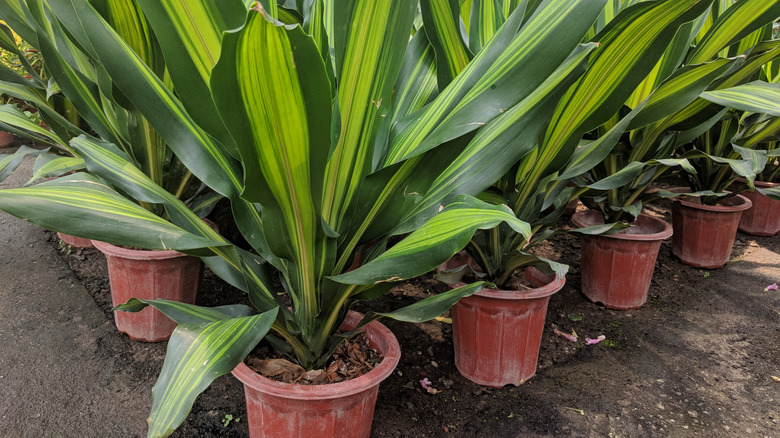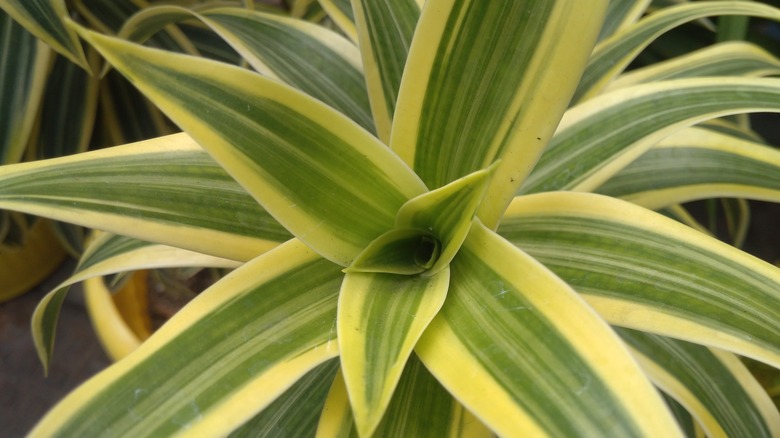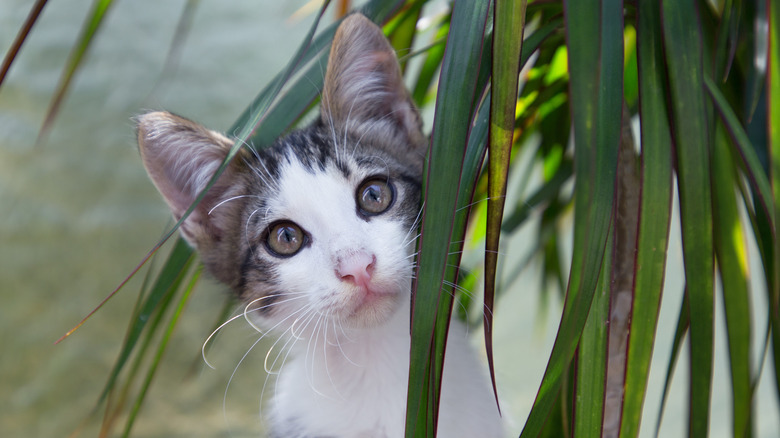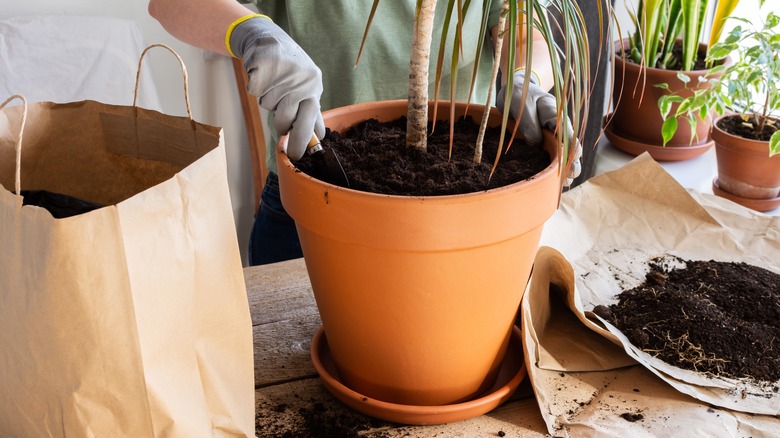How To Care For A Mass Cane Plant
Also known as a corn plant, the mass cane plant (Dracaena fragrans "Massangeana") is native to tropical regions of Africa and Upper New Guinea. They are popular options as houseplants given how easy they are to care for, says Dengarden. Their hardy nature makes them ideal additions for beginners. If growing conditions aren't always followed precisely, the mass cane plant isn't prone to tantrums.
The mass cane plant can grow to be up to 5 to 15 feet tall with long, fern-like foliage. They are versatile plants that can be pruned and maintained at any size desired, provided it is larger than 6 inches, explains SFGate. The mass cane plant's adaptable behavior and easy care make them a go-to option for ornamental purposes, such as office décor. They are not as capable of flowering in their containers as indoor houseplants, but they are incredibly popular for their long, dramatic foliage that is similar to palms and bamboo-like stems.
How to grow mass cane plant
Propagation of a mass cane plant can be accomplished via cutting a piece of cane from the main plant. When it comes time to prune your mass cane plant, consider propagating the cuttings. The piece of cane may then be rooted in either soil or water, says Gardening Know How. To root in soil, insert the cane in a small pot of well-draining material, such as sand or perlite. Keep the potting medium moist. When new growth begins at the top of the cane, this means the plant is sufficiently rooted and is ready to be repotted.
To grow the roots via water, place the cane in a glass of water and leave in a location that has plenty of bright, indirect light, such as a windowsill or shelf. When the roots begin to grow in the water, your baby mass cane plant is ready to be relocated to a container of well-draining soil.
How to care for mass cane plant
Mass cane plants prefer indirect sunlight or partial shade. According to SFGate, mass cane plants will scorch if left in direct sunlight for prolonged periods, and their color will not fully develop. A soil pH of around 6 to 6.5 is ideal. They prefer loamy soil, according to the University of Florida. Loamy soil is well-draining soil, which retains just enough moisture for the roots to absorb what is needed but also drains quickly enough to avoid root rot, explains The Spruce. Soil should be moist but should never be soggy. Allow the soil to dry completely before watering. Because they are slow-growing plants, you can likely water once a week. If the tips of the leaves begin to dry out, increase how often you water, says SFGate.
Gardening Know How recommends applying a balanced houseplant fertilizer every two weeks through the spring and summer. Reduce feedings to monthly during the fall and stop feeding through the winter to encourage a dormant period.
SFGate suggests controlling the mass cane plant's height by pruning canes during the growing season of spring and summer. Cut the mass cane plant's canes approximately ¼ inch above a leaf node with sanitized shears to avoid disease. New growth will sprout from the cane's pruned area within a month. You can also pinch off unwanted side shoots as they develop over the growing season.
Mass Cane Plant Varieties
There are over twenty species and cultivars in the dracaena family, according to Today's Gardener. All of the species are native to tropical regions of Africa. Petal Republic says some cultivars will bleed a red sap when pruned. This sap has been historically used for dyes or gastrointestinal relief, and the resins are burned as incense.
- The Song of India (Dracaena reflexa "Song of India") is native to Madagascar. While it generally does not produce flowers when kept in indoor containers, the Song of India can produce white flowers when grown in their native, tropical environment.
- Dracaena draco, also called the Dragon Tree, is often kept as an indoor succulent, but can grow up to 25 feet tall in a tropical environment, says Plant Care Today. Just like the Song of India, the Dragon Tree variety will resist flowering in indoor environments but can produce orange fruits and white flowers when growing in its natural habitat. Of all the varieties, this one is most suited for outdoor growing.
- The Dracaena hookeriana is described by Today's Gardener as an evergreen shrub and is perfect for container gardening due to its compact size.
- Dracaena deremensis "Lemon Surprise" has dark green foliage that is striped on the edges with bright lime green.
- The White Jewel (Dracaena deremensis "White Jewel") has wavy green foliage that is striped with both dark green and light green. The White Jewel is ideal as a houseplant because it does not grow to be tall.
Is mass cane plant toxic?
The mass cane plant is not considered to be toxic to humans, but they are toxic to dogs and cats. According to Gardening Know How, mass cane plant leaves are toxic to both cats and dogs due to high amounts of glycoside saponin. If you think your pet may have ingested some of the mass cane plant, watch for signs of vomiting, diarrhea, loss of appetite, excessive salivating, and lethargy. Cats may also experience dilated pupils, says the ASPCA. Adverse reactions will be stronger and more serious in smaller dog breeds.
Contact your veterinarian at the first sign of these symptoms. While consuming the plant won't immediately be fatal to a dog or cat, the vomiting and diarrhea can quickly lead to dehydration, which is dangerous and can be fatal if left untreated. And, if your pet is a notorious leaf nibbler, consider repotting your mass cane plant in a hanging basket or moving it to a high shelf where it will be out of reach.
How to repot a mass cane plant
According to SFGate, mass cane plants prefer a snug container fit. Because they grow slowly, repotting the mass cane plant should only be necessary about every other year or so during the spring. When upgrading containers, the new pot should only be about two inches deeper or wider. The soil should be well-draining. To avoid root rot, make sure your new container has drainage holes, so the roots do not sit in water.
Fill the new, sterilized container with fresh potting soil about halfway. Gently roll the mass cane plant's current container onto its side and ease the plant out of the container. Carefully shake the old soil from the roots. Plantly recommends trimming away any dark or rotting roots with sterilized shears before placing the mass cane plant into the new container. Fill the empty space around the roots and cane stem with fresh soil. Water the mass cane plant well after repotting.
If the mass cane plant is tall, it may become top-heavy and may fall over. Gardening Mentor suggests adding a brick to the bottom of your container to provide a counterbalance. Gardening Know How acknowledges that sometimes plants can simply become too large to physically repot. Should you find your mass cane plant is too big for you to repot, you can replace the top three inches of soil once a year. This process, known as top dressing, will help provide much-needed nutrients to the plant without damaging it.
